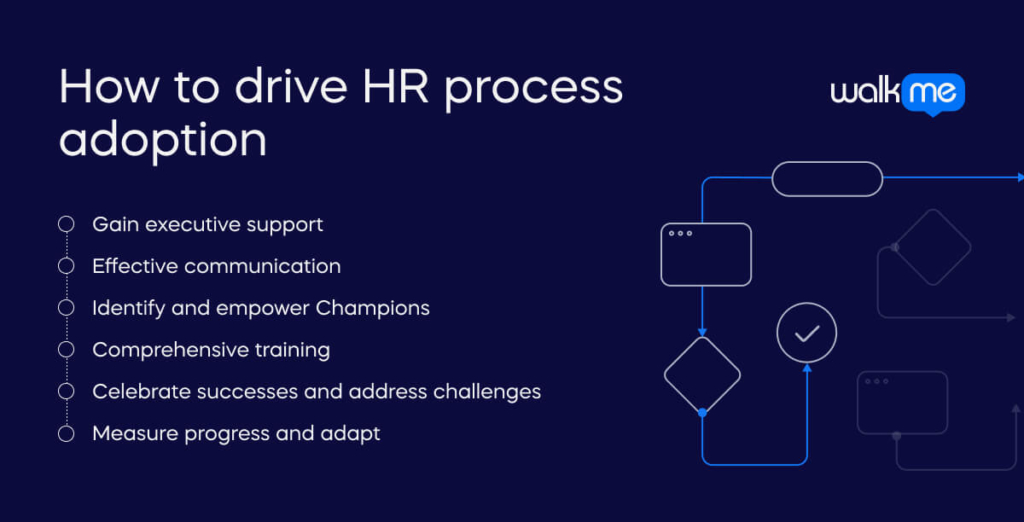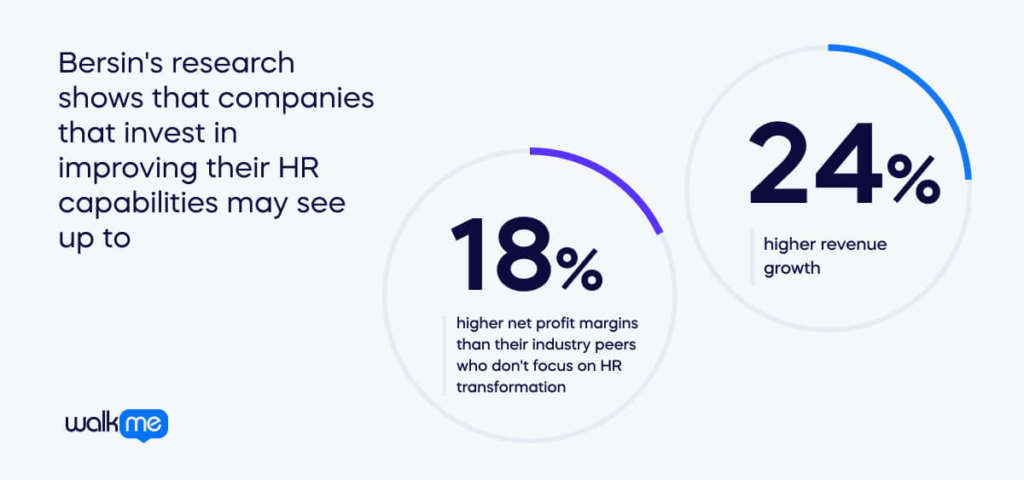No one contributes more to a company’s success than its employees. Achieving collective organizational goals is only possible with a team that is motivated and ready to work toward them.
That’s where HR comes in. HR ensures businesses know how to manage their most important asset–their people.
Tech investments, changing work styles, and updates to the old business ways mean HR workflows must constantly change to keep up.
Add in changing employee expectations and industry-wide digital transformations, and today’s HR leaders, now more than ever, need to find new ways of doing things. This requires being flexible, planning ahead, and helping employees prepare for the future of work.
In this article, we’ll explore six straightforward steps for driving HR process adoption. By the end, you’ll understand how to navigate the complexities of HR process adoption within your organization.
What is HR process adoption?
HR process adoption is implementing and integrating new or improved HR processes within an organization. This can include changes to core procedures, workflows, or any activity involved in completing HR functions.
For example, this could mean updating how a company hires new people or the way they track employee performance. HR teams carefully plan these changes to make their work more efficient and support the company’s goals.
How to drive HR process adoption

While the technology and workflows are important, successful HR process adoption requires careful planning and a people-focused approach.
Here are six steps to help drive HR process adoption:
- Gain executive support
Getting your company’s top leaders on board is the foundation for successfully changing HR processes. When executives get behind a change, their enthusiasm and support spread throughout the organization. Start by showing them how the new system fits the company’s bigger goals.
Stress how this change will boost productivity, cut costs, save time, and make employees happier. You can even use real-world examples to show how much the company could benefit. Working together from the planning stage shows executives that their opinions matter and makes them personally invested in the project’s success.
- Effective communication
Communication is the most important part of any successful change. You need to keep everyone involved in the process updated and engaged.
Have a detailed communication plan that answers what, when, where, and how you’ll tell people about the changes. Be honest about why the changes are needed and how they’ll affect workers. Encourage employees to speak up with any worries or questions and address them openly.
Use various ways to get the word out, like meetings, emails, intranet posts, and even casual chats. Celebrate milestones throughout the process to keep everyone excited.
- Identify and empower Champions
Change champions are enthusiastic employees who naturally take the lead. Find potential champions across different departments—they’re the ones who understand the current processes and are excited to learn.
Give them the in-depth knowledge, tools, and power to push for change across the company. Encourage your champions to share their wins and the cool things they’ve learned. These success stories will make others confident and want to join in on the positive change.
Consider creating a formal network where champions can work together, trade tips, and provide support; recognizing their hard work with rewards makes them feel valued and inspires others.
- Comprehensive training
Providing the knowledge and skills your employees need to succeed is vital.
Tailor training to specific job functions and skill levels, providing different options to suit everyone’s learning styles. In-person workshops, online classes, easy-to-follow guides, and the freedom to practice at their own pace are all essential.
Have managers set a positive example, actively helping their team members learn. Don’t stop with just the initial training; provide ways for employees to brush up on skills or become even better at using the new system.
- Celebrate successes and address challenges
Acknowledging even small wins is a huge motivator during change.
Recognize individual and team efforts—highlight achievements in meetings, company newsletters, or other public ways. Employees will get excited when they see their hard work recognized and will keep up the good momentum.
At the same time don’t ignore roadblocks. Encourage employees to come to you with problems so you can work together to find solutions. Showing them you’ll tackle challenges head-on makes employees feel supported and ensures the project is not derailed.
- Measure progress and adapt
Tracking progress helps you know if the change works and where to improve.
Choose key metrics like adoption rate (how many people use the new system), time saved, employee feedback, and more. Gather this data through surveys, system reports, and even one-on-one chats. Study this data to find patterns, what’s going well, and areas needing extra attention.
Why is there a need for HR process adoption?
In a business world that’s always changing, relying on old-fashioned HR methods leads to a standstill.
HR has moved beyond simply handling payroll, onboarding, and paid time off. Today, HR is more of a strategic partner, using data as a powerful tool to understand workforce patterns, predict hiring needs, and make decisions that drive the company forward.
At its core, HR should always prioritize the employee experience—everything from someone’s first job application to their growth within the company. However, waves of digital disruption and shifting employee expectations mean HR can’t do this effectively with outdated systems and procedures. That’s why adopting new processes is key.
New processes make revamping core tasks—from finding the right talent to supporting employee growth—easier. Ultimately, this allows companies to gain an advantage, find and keep top talent, and build a workforce equipped to tackle the fast pace of change.
Let’s take a look at some of the top reasons why adopting new HR processes is a no-brainer for today’s firms:
- The technology race
New HR technologies are always emerging, offering ways to streamline tasks that were once time-consuming and error-prone. Think of it like this: Would you rather track employee attendance in a spreadsheet or use a system that automatically calculates hours worked?
HR process adoption allows companies to ditch old methods and harness the power of automation.
- The rise of the gig economy
More businesses are relying on freelancers, consultants, and temporary workers. Traditional HR processes are often not designed to handle this flexible workforce.
Adopting new processes ensures that these “gig workers” are seamlessly managed—they get paid on time, access necessary resources, and feel like valued members of the broader team.
- The demand for data
Businesses today crave data-driven insights to make better decisions. HR teams can’t provide that without the right processes.
Imagine a company debating whether to expand into a new city. HR process adoption allows them to access and analyze data about hiring trends, salary expectations, and overall talent availability in that market, leading to far smarter and more informed decisions.
- The employee experience imperative
Today’s Top talent has more choices than ever. To attract and keep the best people, companies must offer a smooth and positive employee experience from day one.
Outdated HR processes (think slow onboarding and clunky benefits enrollment) can lead to frustration and a feeling that the company doesn’t value its employees’ time.
Adopting new processes signals the company’s commitment to making life easier for its workforce.
What are the benefits of HR process adoption?
When companies update and improve their HR processes, it’s not just about making HR’s job easier—there are benefits across the entire organization.
Bersin’s research shows that companies that invest in improving their HR capabilities may see up to 24% higher revenue growth and up to 18% higher net profit margins than their industry peers who don’t focus on HR transformation.

Here’s what HR process adoption can help to achieve:
More efficient
Streamlined processes save time and money. Think about how automating a task like benefits enrollment frees up HR teams to focus on more strategic work.
Data-backed insights
Modern HR processes are designed to collect and analyze data about the workforce. This gives companies valuable insights into hiring trends, employee satisfaction, and potential skills gaps.
Improved compliance
Outdated processes can lead to costly mistakes and legal issues. Process adoption ensures that the company follows all the latest employment laws and regulations.
Better employee experience
Smooth, consistent HR experiences make employees feel valued and supported. This helps attract top talent and retain the best people in the company.
What are the challenges to HR process adoption?
Implementing new HR processes can be challenging. Here are some common challenges companies face when embarking on HR process adoption:
Change management
Getting employees on board with new ways of doing things can be difficult. Clear communication and training are essential.
Technology selection and integration
Choosing the right HR toolkit and making it work with existing systems can be complex and time-consuming.
Cost and resources
New processes and technology can be an investment. Business leaders need to understand the long-term benefits outweigh the up-front costs.
Change resistance
Some employees and even HR team members may be comfortable with the old ways of doing things. Overcoming this mindset and limiting change resistance is crucial for successful implementation.
Mastering HR process adoption: Achieving excellence
Use this knowledge to refine your approach as you move forward, and remember that flexibility is key to ensuring the success of any change initiative.
Implementing new HR processes takes focus, strategy, and a multifaceted approach. By securing executive support, communicating, empowering change champions, providing training, celebrating achievements, and continuously refining your approach, you’ll set up your organization for smooth adoption and long-term success.
When people are the priority in HR process adoption, employees feel valued, collaboration flourishes, and the company thrives.

